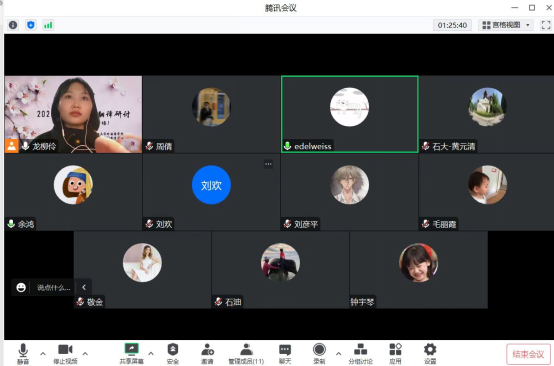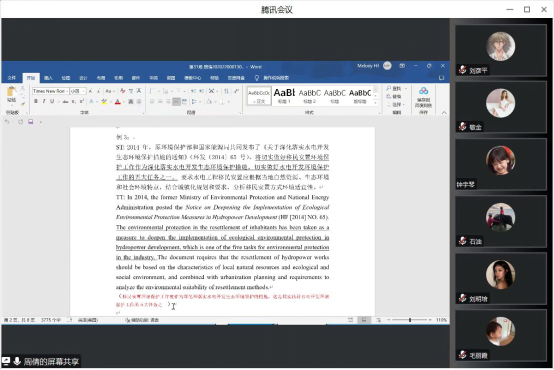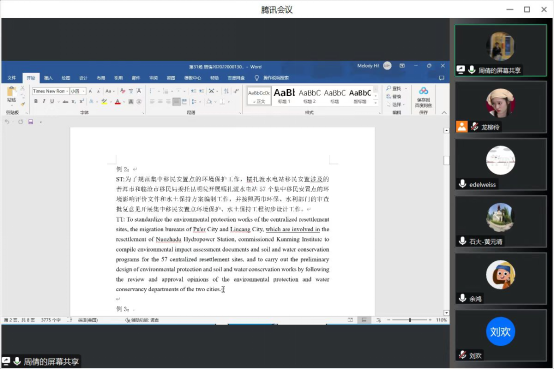汇报时间:2023年3月2日20:00-21:30
汇报地点:腾讯会议:797-518-188
汇报学生:周倩
指导教师:李渝
汇报题目:《中国超级水电工程生态环境工程创新技术》(第7章7.1.1-7.5.1)汉英翻译实践报告
参与导师:李渝、余鸿、黄元清
内容简介:
翻译材料选自国家出版基金项目——大国重器·中国超级水电工程(糯扎渡卷)分册:《中国超级水电工程生态环境工程创新技术》。全书共13万字,分为十章。笔者选取第七章(7.1.1-7.5.1)共计16306字作为源文本,其主要内容为移民安置环境保护工程的概况、国家对移民安置环境保护的相关政策法规要求、农村污染防治技术及应用情况、集中移民安置点生活污水处理工程和生活垃圾处置工程的施工方案。
源文本具有如下特点:
1. 源文本属于工程类文本,专业性较强,因此术语较多且语言严谨。
2. 源文本句式多样,既有许多并列短句又有大量长难句。如何处理各类句型从而做到准确传达源文本意义,对译者是一大挑战。
译文修改:
例1:
ST: 尽管糯扎渡水电站移民安置点环保水保工程初步设计工作已于2014年年底完成,但糯扎渡水电站移民安置点环保水保工程符合《意见》的要求,其设计实施和管理经验对当地政府贯彻落实中共中央国务院《关于加快推进生态文明建设的意见》和《水污染防治行动计划》具有重要意义。
TT1: The preliminary design of the environmental protection and water conservation work of the resettlement site of Nuozhadu Hydropower Station has been completed by the end of 2014, but this work met the requirements of Opinions. Its design and implementation, as well as management experience, have great significance for the local government to implement the Opinions on Accelerating the Construction of Ecological Civilization and Action Plan for Water Pollution Control, published by the Central Committee and State Council of the Communist Party of China.
TT2: The preliminary design of the environmental protection and water conservation work of the resettlement site of Nuozhadu Hydropower Station has been completed by the end of 2014. This work is in line with Opinions, its design and implementation, as well as management experience, still have great significance for the local government to implement the Opinions on Accelerating the Construction of Ecological Civilization and Action Plan for Water Pollution Control, published by the Central Committee and State Council of the Communist Party of China.
例2:
ST:不足:沉积污泥多,需定期进行清理,综合效益不高,污水易渗漏。化粪池处理效果有限,出水水质差,不能直接排放水体,一般用于村庄周边的农田灌溉。如果外排,需经后续好氧生物处理单元或生态技术单元进一步处理。通过化粪池的预处理可有效防止管道堵塞,亦可有效降低后续处理单元的污染负荷。
TT1: Disadvantages: There is a lot of deposited sludge, which needs to be cleaned regularly, and it brings low comprehensive benefit and the sewage is easy to leak. Besides, the treatment effect of septic tanks is not well, which leads to poor water quality, thus the water could not be discharged directly, so generally, they are used for farmland irrigation around villages. When discharged, it needs to be further treated by a subsequent aerobic biological treatment unit or ecological technology unit. The pretreatment of septic tanks can effectively prevent pipeline blockage and reduce the pollution load of subsequent processing.
TT2: Disadvantages: The deposited sludge needs to be cleaned regularly. Otherwise, it will bring low comprehensive benefit and the sewage is easy to leak. Besides, the treatment effect of septic tanks is not well, which leads to poor water quality, so the water could not be discharged directly. It is generally used for farmland irrigation around villages. Before discharge, it needs to be further treated by a subsequent aerobic biological treatment unit or ecological technology unit. The pretreatment of septic tanks can effectively prevent pipeline blockage and reduce the pollution load of subsequent processing.
例3:
ST:水流以极低的速度在湿地内均匀流动,通过生物助凝、吸附、周丛生物(包括微生物)降解、植物营养盐吸收、微生物同化等机制净化污水,大大提高湿地对污染物处理负荷,并利用根部形成的高生物量的生物膜、内部小生态系统和湿地植物自身吸收作用等去除污水中的有机污染物及氮、磷营养物质。
TT1: The water flows regularly in the wetland at a very low speed. The sewage is purified through biological coagulation, adsorption, degradation of periphytic organisms (including microorganisms), absorption of plant nutrients, microbial assimilation, and other mechanisms, which can greatly improve the pollutant treatment load of the wetland. Organic pollutants and nitrogen and phosphorus nutrients in sewage are removed by high biomass biofilm formed in roots, internal small ecosystems, and wetland plants’ absorption.
TT2: The water flows regularly in the wetland at a very low speed, which contributes to the treatment of sewage. On the one hand, the sewage is purified through biological coagulation, adsorption, degradation of periphytic organisms (including microorganisms), absorption of plant nutrients, microbial assimilation, and other mechanisms, which can greatly improve the pollutant treatment load of the wetland. On the other hand, Organic pollutants and nitrogen and phosphorus nutrients in sewage are removed by high biomass biofilm formed in roots, internal small ecosystems, and wetland plants’ absorption.
研讨反思:
通过此次翻译研讨,对翻译的过程有了更加清楚的认识,主要的收获有以下三点:
第一、不要局限于句子,要以整体的角度看译文。通过与老师们的案例讨论,发现自己在上下文的衔接上没有处理得当,这主要归因于对文本的理解不够准确和深入,所以下一阶段要不断打磨推敲句子之间的关系,体现译文的逻辑性和连贯性;
第二、受中文束缚的问题较为突出。由于原文属于工程类文本,存在大量长难句,且句式揉杂的情况较多,译者很容易陷入中文思维方式的陷阱,使译文得不到清楚的表达。通过与老师的探讨认识到,译者要准确分析句子结构,摆脱原文句式的影响,灵活采用不同的翻译技巧,以写出地道的英文译文;
第三、注意翻译的简洁性。在源文本中有很多同义词或范畴词,或一一译出会导致译文冗余,使目的语读者理解困难。通过探讨,译者也意识到了语言表达简洁性的重要性。


